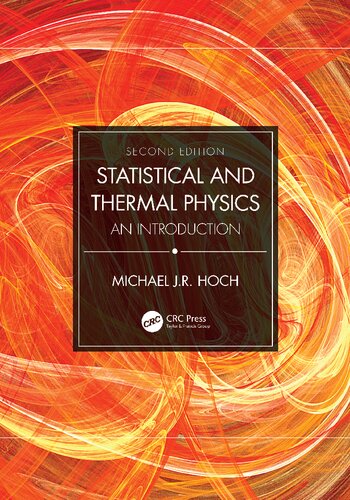

Most ebook files are in PDF format, so you can easily read them using various software such as Foxit Reader or directly on the Google Chrome browser.
Some ebook files are released by publishers in other formats such as .awz, .mobi, .epub, .fb2, etc. You may need to install specific software to read these formats on mobile/PC, such as Calibre.
Please read the tutorial at this link. https://ebooknice.com/page/post?id=faq
We offer FREE conversion to the popular formats you request; however, this may take some time. Therefore, right after payment, please email us, and we will try to provide the service as quickly as possible.
For some exceptional file formats or broken links (if any), please refrain from opening any disputes. Instead, email us first, and we will try to assist within a maximum of 6 hours.
EbookNice Team

Status:
Available5.0
11 reviewsThermal and statistical physics has established the principles and procedures needed to understand and explain the properties of systems consisting of macroscopically large numbers of particles. By developing microscopic statistical physics and macroscopic classical thermodynamic descriptions in tandem, Statistical and Thermal Physics: An Introduction provides insight into basic concepts and relationships at an advanced undergraduate level. This second edition is updated throughout, providing a highly detailed, profoundly thorough, and comprehensive introduction to the subject and features exercises within the text as well as end-of-chapter problems.
Part I of this book consists of nine chapters, the first three of which deal with the basics of equilibrium thermodynamics, including the fundamental relation. The following three chapters introduce microstates and lead to the Boltzmann definition of the entropy using the microcanonical ensemble approach. In developing the subject, the ideal gas and the ideal spin system are introduced as models for discussion. The laws of thermodynamics are compactly stated. The final three chapters in Part I introduce the thermodynamic potentials and the Maxwell relations. Applications of thermodynamics to gases, condensed matter, and phase transitions and critical phenomena are dealt with in detail.
Initial chapters in Part II present the elements of probability theory and establish the thermodynamic equivalence of the three statistical ensembles that are used in determining probabilities. The canonical and the grand canonical distributions are obtained and discussed. Chapters 12-15 are concerned with quantum distributions. By making use of the grand canonical distribution, the Fermi–Dirac and Bose–Einstein quantum distribution functions are derived and then used to explain the properties of ideal Fermi and Bose gases. The Planck distribution is introduced and applied to photons in radiation and to phonons on solids. The last five chapters cover a variety of topics: the ideal gas revisited, nonideal systems, the density matrix, reactions, and irreversible thermodynamics. A flowchart is provided to assist instructors on planning a course.
Key Features:
Michael J.R. Hoch spent many years as a visiting scientist at the National High Magnetic Field Laboratory at Florida State University, USA. Prior to this, he was a professor of physics and the director of the Condensed Matter Physics Research Unit at the University of the Witwatersrand, Johannesburg, where he is currently professor emeritus in the School of Physics.